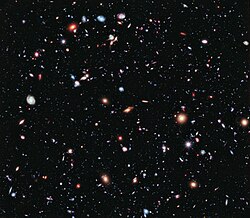Fysik 1
| Fysik 1 | |
 Universums utveckling behandlas i kursen. | |
| Läroplan | Gy 2011 |
|---|---|
| Kurskod | FYSFYS01X |
| Poäng | 1a, 150; 1b1, 100; 1b2, 50 |
| Betyg | A–E, godkänd; F, icke godkänd |
| Nationella program | Naturvetenskap Teknik |
| Motsvarar | ≈ Fysik A (Lpf 94) |
Fysik 1 är ett samlingsbegrepp för 100-poängskursen Fysik 1b1 som kan kompletteras med 50-poängskursen Fysik 1b2, och 150-poängs kursen Fysik 1a som innefattar materialet i både Fysik 1b1 och 1b2. Kurserna kan erbjudas på gymnasieskolan och Komvux i Sverige. Kursen Fysik 1a är ett obligatoriskt programgemensamt ämne på naturvetenskapsprogrammet och teknikprogrammet.
Innehåll [1]
- Mätningar och mätvärden
- Krafter, jämvikt och tryck
- Energi
- Laddningar och fält
- Spänning, ström och effekt
- Termodynamik
- Linjebunden rörelse
- Kraft och rörelse
- Atom och kärnfysik
- Modern fysik
- Universums utveckling
Se även
Referenser
- ^ ”Komvux: Undervisningsplanering i Fysik Kurs 1 (150 poäng)” (PDF). Arkiverad från originalet den 5 mars 2016. https://web.archive.org/web/20160305030259/http://www.komvux.org/egn/Kurser/Fysik/Kursplan%20A%20Fy1201.pdf. Läst 29 augusti 2011.
Externa länkar
”FY1201 - Fysik 1”. Arkiverad från originalet den 21 november 2007. https://web.archive.org/web/20071121052434/http://www3.skolverket.se/ki03/front.aspx?sprak=SV&ar=0708&infotyp=5&skolform=21&id=3053&extraId=. Läst 29 augusti 2011.
 Fysik 1 på Wikibooks.
Fysik 1 på Wikibooks.
| ||||||||
Media som används på denna webbplats
This image, called the Hubble eXtreme Deep Field (XDF), combines Hubble observations taken over the past decade of a small patch of sky in the constellation of Fornax. With a total of over two million seconds of exposure time, it is the deepest image of the Universe ever made, combining data from previous images including the Hubble Ultra Deep Field (taken in 2002 and 2003) and Hubble Ultra Deep Field Infrared (2009).
The image covers an area less than a tenth of the width of the full Moon, making it just a 30 millionth of the whole sky. Yet even in this tiny fraction of the sky, the long exposure reveals about 5500 galaxies, some of them so distant that we see them when the Universe was less than 5% of its current age.
The Hubble eXtreme Deep Field image contains several of the most distant objects ever identified.